Abstract
The behavioral research on teaching individuals who have profound multiple handicaps is reviewed. The primary focus is on determining the degree to which behavioral research has demonstrated the teaching of meaningful skills to this population. Results of the review indicate that investigations have demonstrated, albeit inconsistently, that behavior change has resulted from contingency management interventions with persons who have profound multiple handicaps. However, there is little evidence that such interventions have resulted in meaningful behavior change according to currently accepted criteria for beneficially affecting the quality of life of persons with serious handicaps. Potential explanations for the lack of such evidence are offered, including the relative lack of research attention given to this issue, the possible ineffectiveness of the components of the technology applied, and possible ineffective application of the potentially effective technology. Suggestions for future research are discussed in terms of developing more effective educational and habilitative services for persons with profound multiple handicaps. In particular, we suggest research on a wider variety of behavioral teaching procedures, providing more comprehensive evaluations of the applications of procedures and developing treatment programs that do not focus solely on traditional skill acquisition.
Full text
PDF



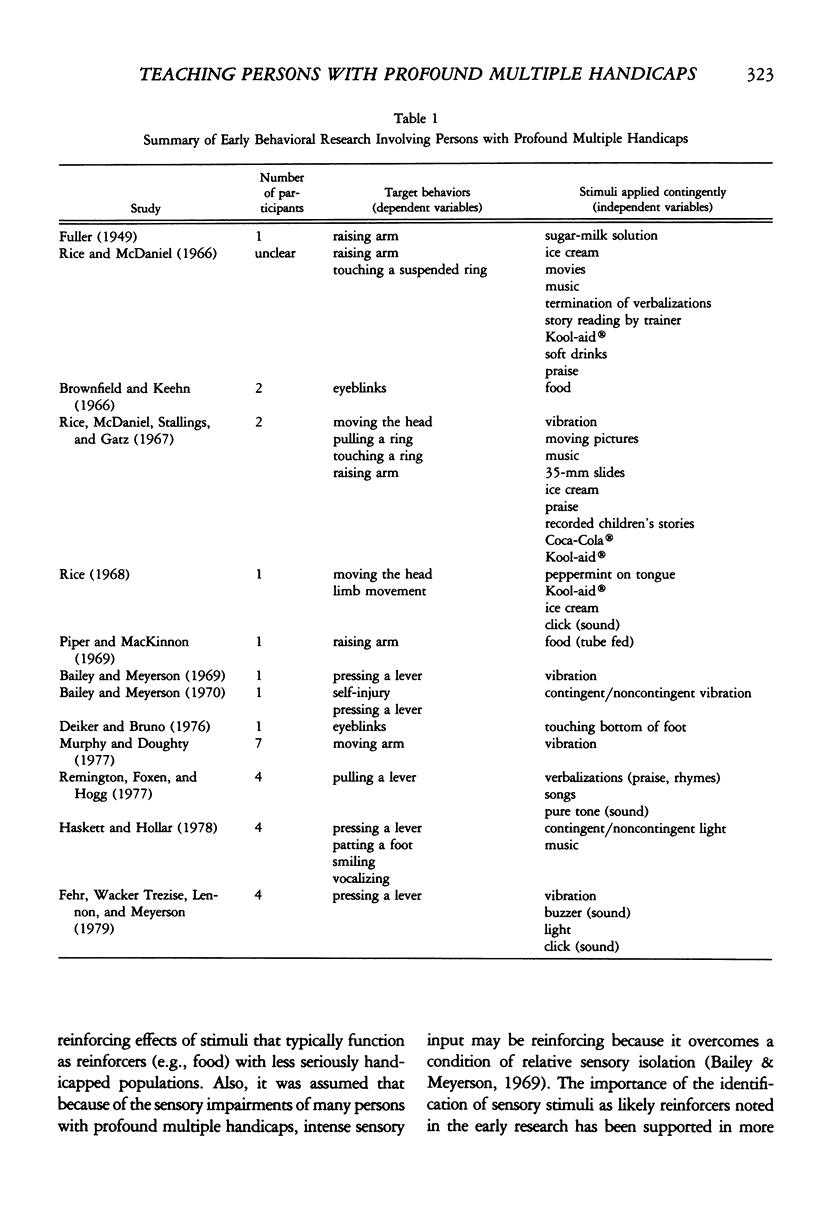
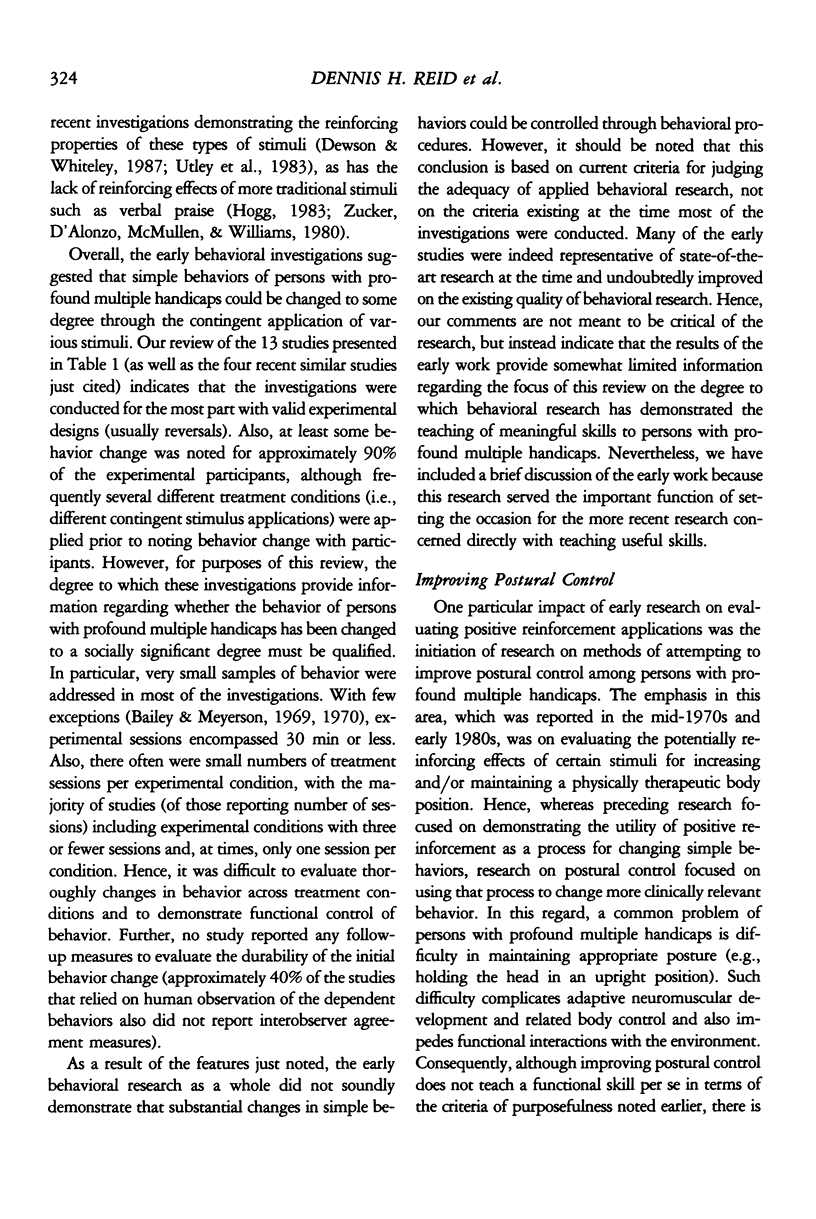
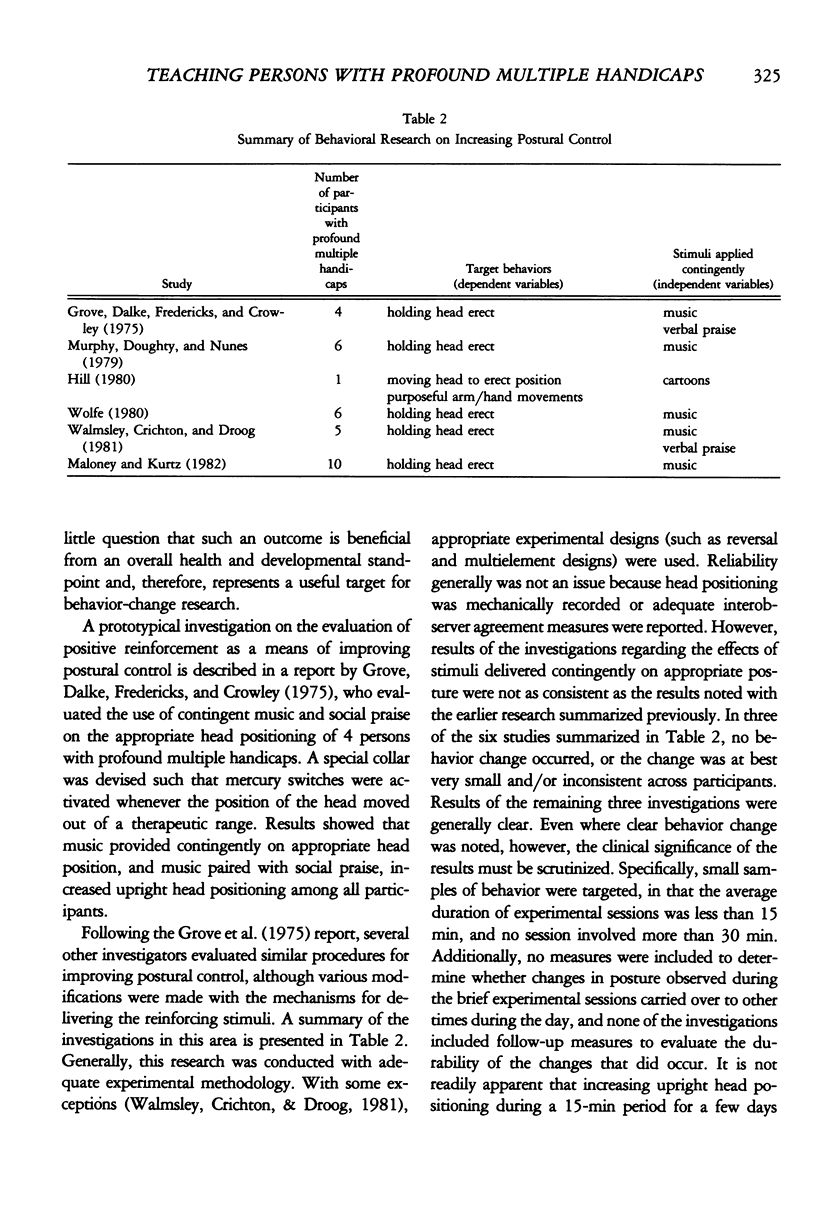

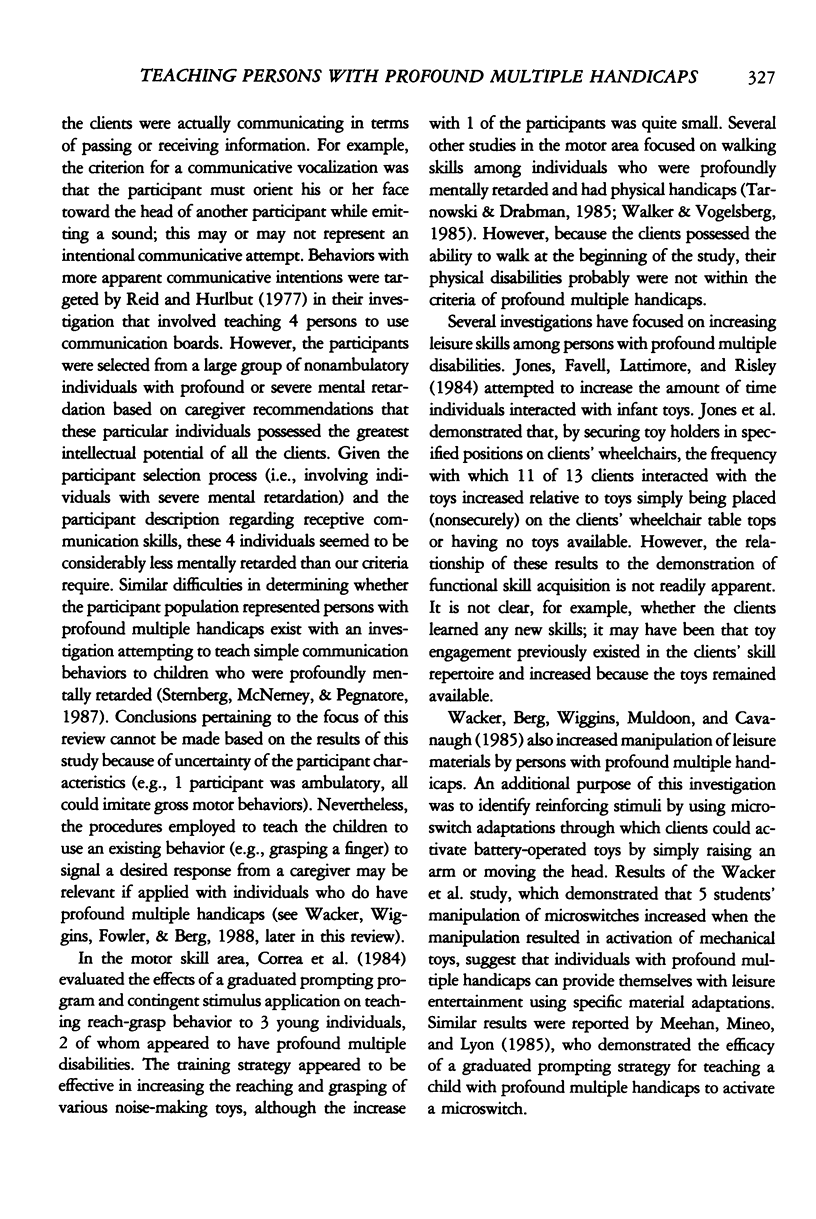


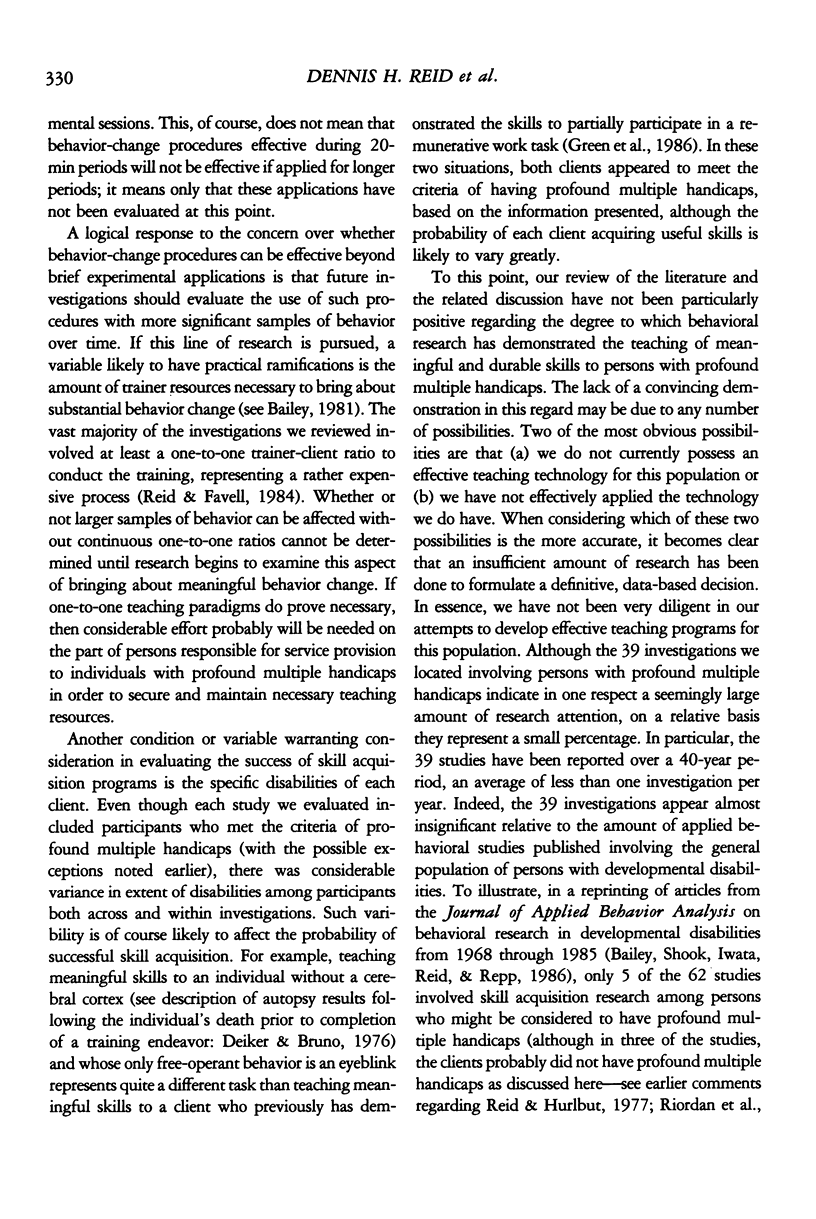
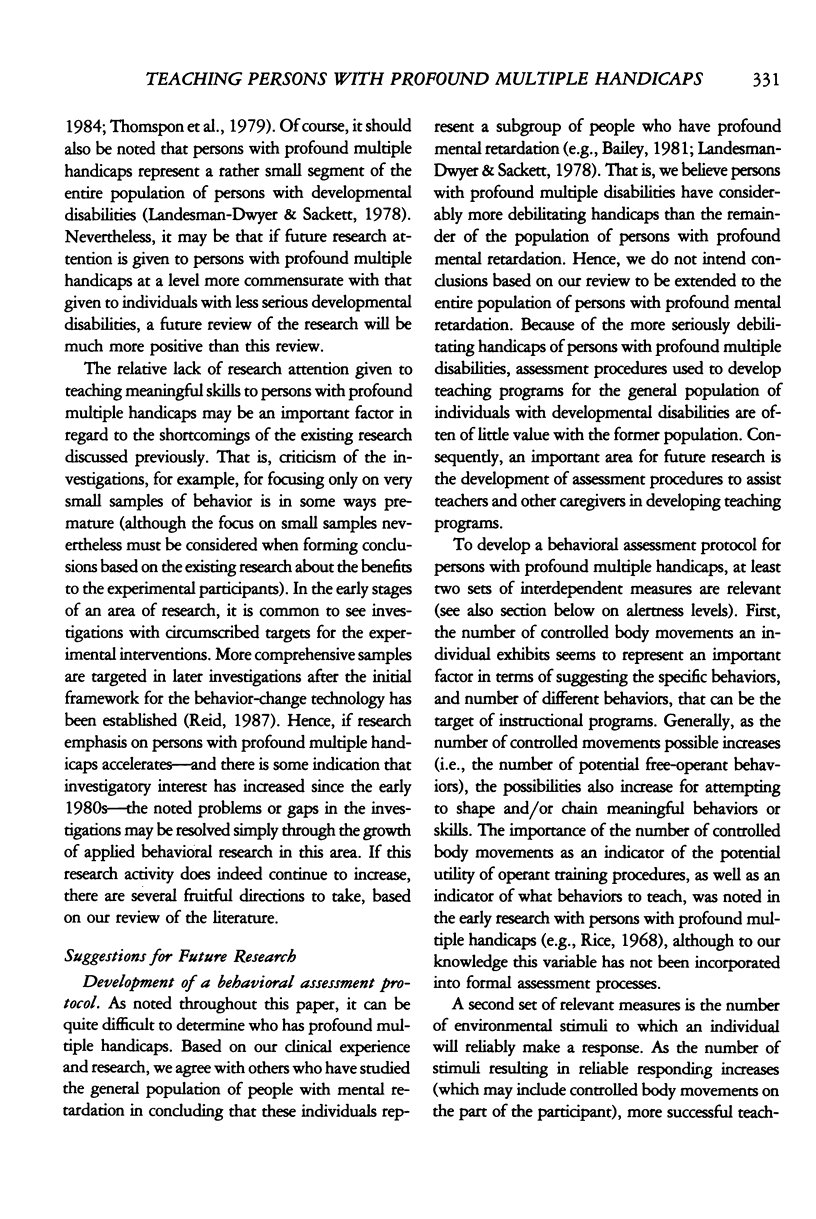
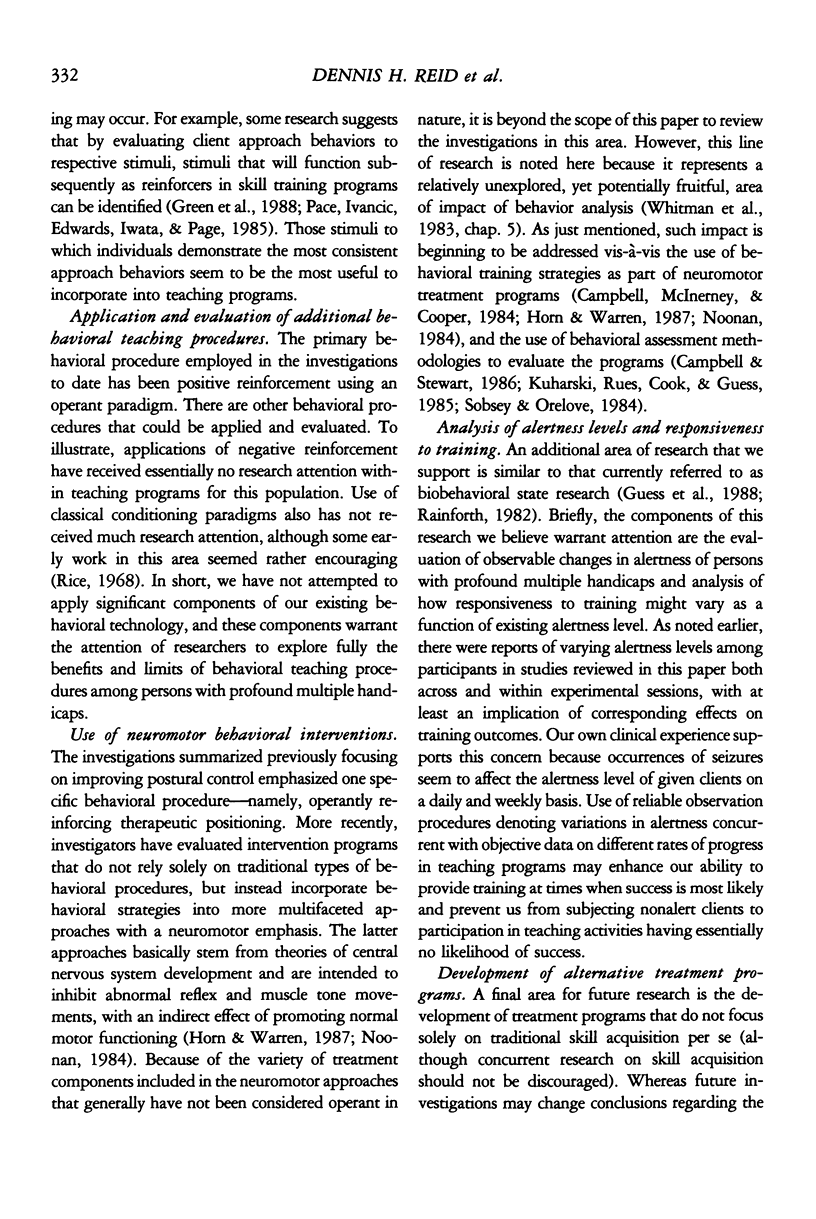
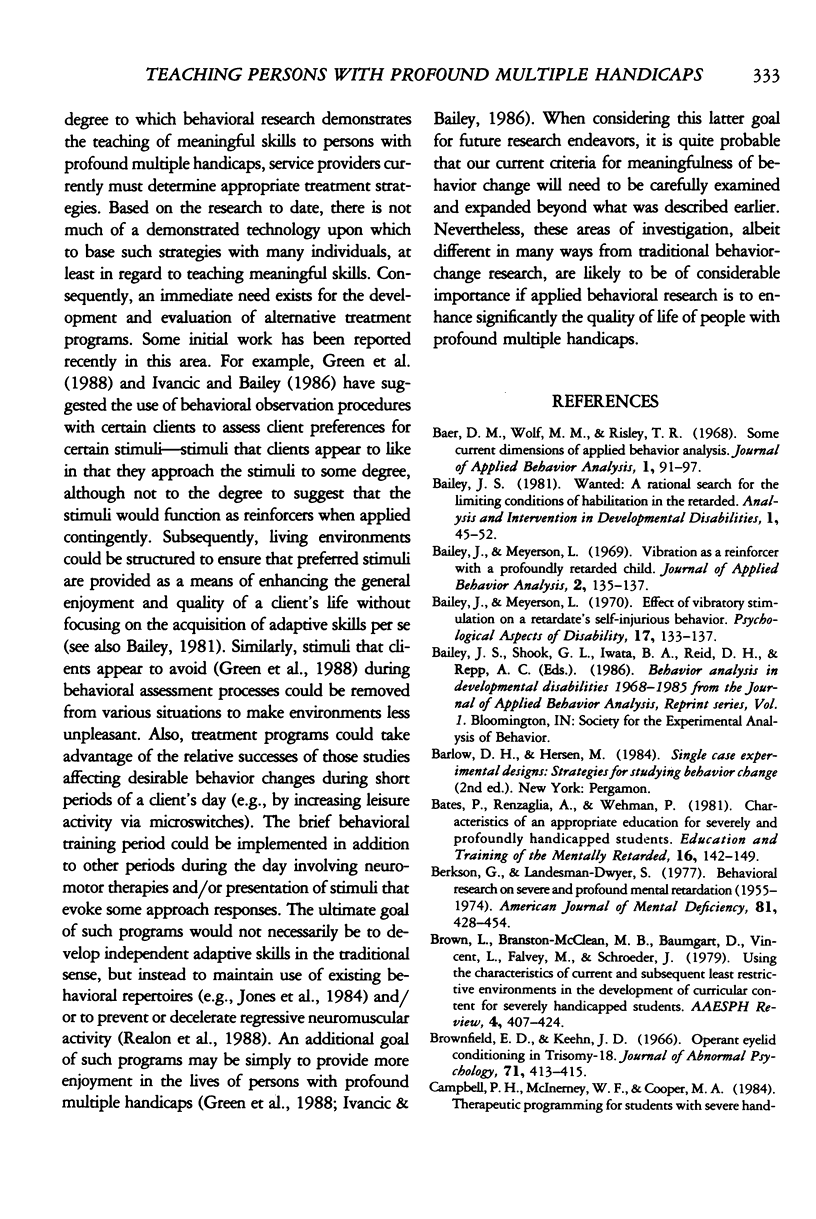
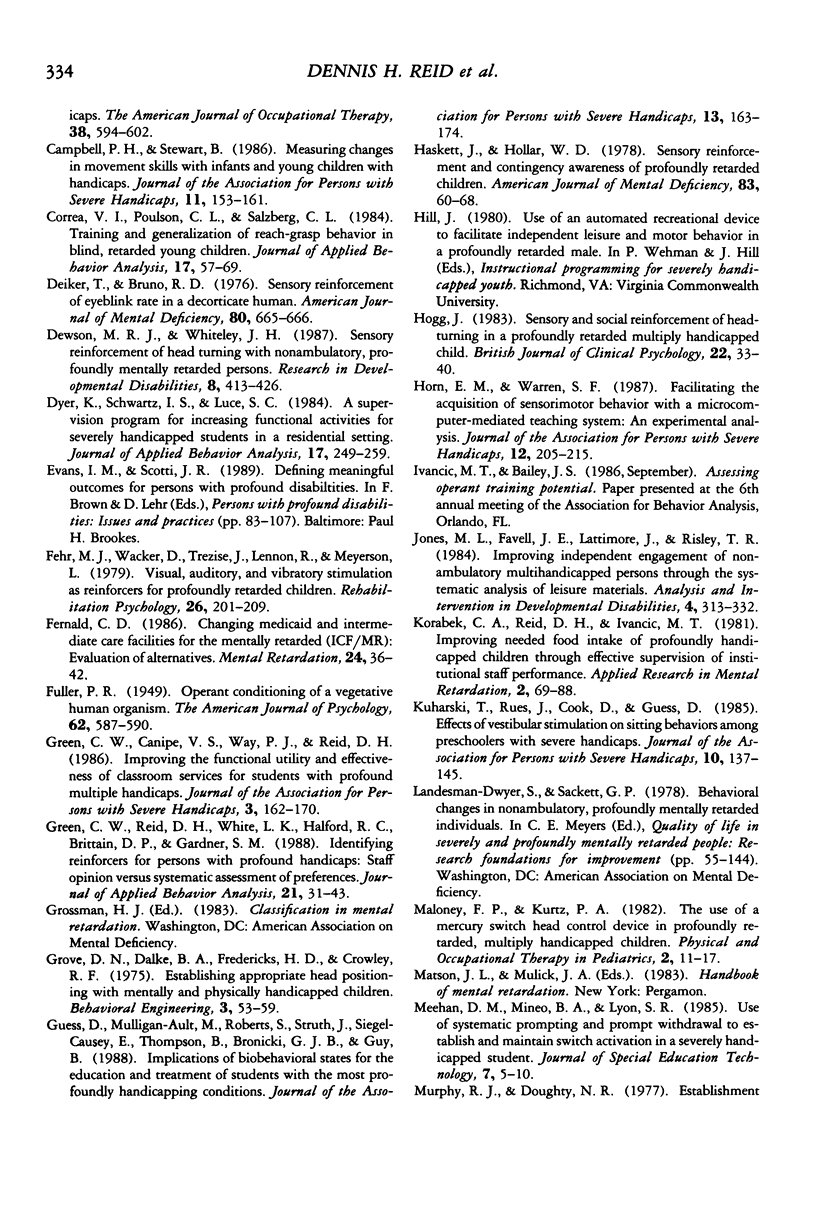
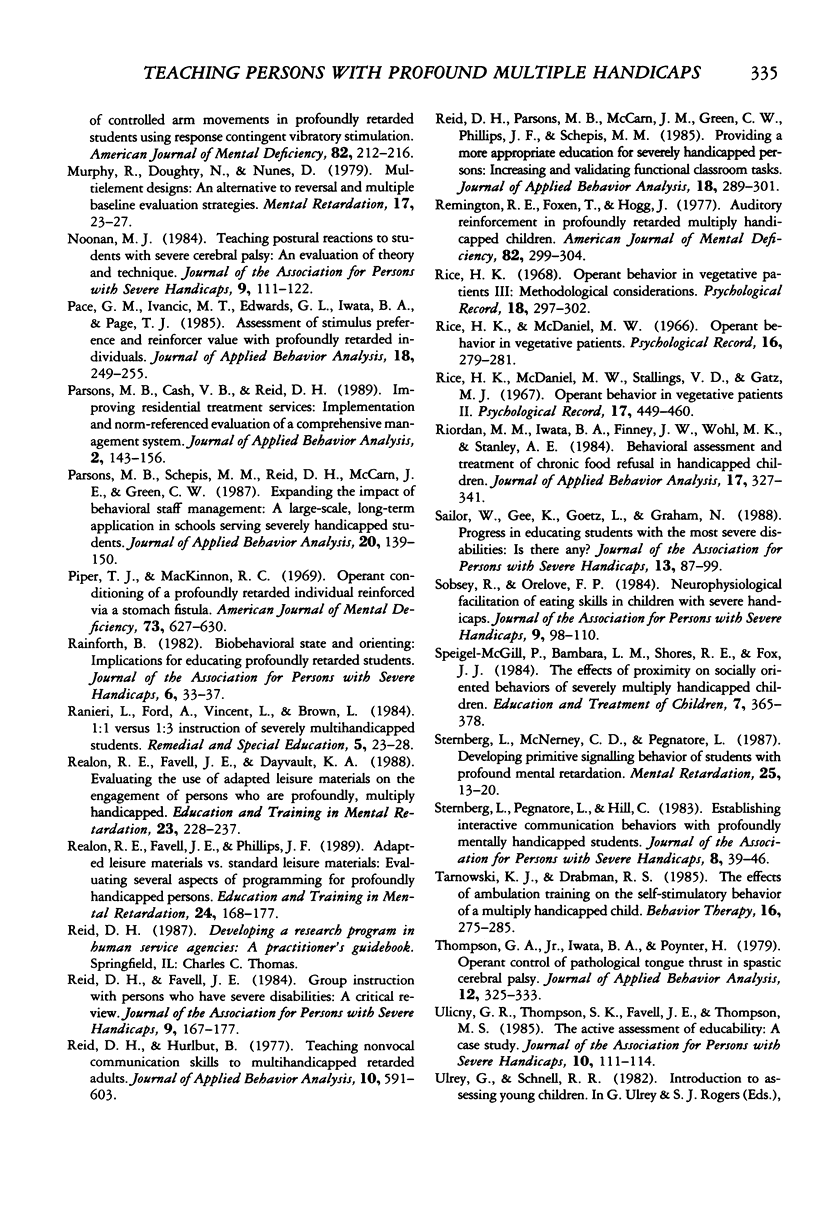

Selected References
These references are in PubMed. This may not be the complete list of references from this article.
- Baer D. M., Wolf M. M., Risley T. R. Some current dimensions of applied behavior analysis. J Appl Behav Anal. 1968 Spring;1(1):91–97. doi: 10.1901/jaba.1968.1-91. [DOI] [PMC free article] [PubMed] [Google Scholar]
- Bailey J., Meyerson L. Vibration as a reinforcer with a profoundly retarded child. J Appl Behav Anal. 1969 Summer;2(2):135–137. doi: 10.1901/jaba.1969.2-135. [DOI] [PMC free article] [PubMed] [Google Scholar]
- Berkson G., Landesman-Dwyer S. Behavioral research on severe and profound mental retardation (1955--1974). Am J Ment Defic. 1977 Mar;81(5):428–454. [PubMed] [Google Scholar]
- Brownfield E. D., Keehn J. D. Operant eyelid conditioning in trisomy-18. J Abnorm Psychol. 1966 Dec;71(6):413–415. doi: 10.1037/h0023971. [DOI] [PubMed] [Google Scholar]
- Campbell P. H., McInerney W. F., Cooper M. A. Therapeutic programming for students with severe handicaps. Am J Occup Ther. 1984 Sep;38(9):594–602. doi: 10.5014/ajot.38.9.594. [DOI] [PubMed] [Google Scholar]
- Correa V. I., Poulson C. L., Salzberg C. L. Training and generalization of reach-grasp behavior in blind, retarded young children. J Appl Behav Anal. 1984 Spring;17(1):57–69. doi: 10.1901/jaba.1984.17-57. [DOI] [PMC free article] [PubMed] [Google Scholar]
- Deiker T., Bruno R. D. Sensory reinforcement of eyeblink rate in a decorticate human. Am J Ment Defic. 1976 May;80(6):665–667. [PubMed] [Google Scholar]
- Dewson M. R., Whiteley J. H. Sensory reinforcement of head turning with nonambulatory, profoundly mentally retarded persons. Res Dev Disabil. 1987;8(3):413–426. doi: 10.1016/0891-4222(87)90023-0. [DOI] [PubMed] [Google Scholar]
- Dyer K., Schwartz I. S., Luce S. C. A supervision program for increasing functional activities for severely handicapped students in a residential setting. J Appl Behav Anal. 1984 Summer;17(2):249–259. doi: 10.1901/jaba.1984.17-249. [DOI] [PMC free article] [PubMed] [Google Scholar]
- FULLER P. R. Operant conditioning of a vegetative human organism. Am J Psychol. 1949 Oct;62(4):587–590. [PubMed] [Google Scholar]
- Fernald C. D. Changing Medicaid and intermediate care facilities for the mentally retarded (ICF/MR): evaluation of alternatives. Ment Retard. 1986 Feb;24(1):36–42. [PubMed] [Google Scholar]
- Green C. W., Reid D. H., White L. K., Halford R. C., Brittain D. P., Gardner S. M. Identifying reinforcers for persons with profound handicaps: staff opinion versus systematic assessment of preferences. J Appl Behav Anal. 1988 Spring;21(1):31–43. doi: 10.1901/jaba.1988.21-31. [DOI] [PMC free article] [PubMed] [Google Scholar]
- Haskett J., Hollar W. D. Sensory reinforcement and contingency awareness of profoundly retarded children. Am J Ment Defic. 1978 Jul;83(1):60–68. [PubMed] [Google Scholar]
- Hogg J. Sensory and social reinforcement of head-turning in a profoundly retarded multiply handicapped child. Br J Clin Psychol. 1983 Feb;22(Pt 1):33–40. doi: 10.1111/j.2044-8260.1983.tb00576.x. [DOI] [PubMed] [Google Scholar]
- Korabek C. A., Reid D. H., Ivancic M. T. Improving needed food intake of profoundly handicapped children through effective supervision of institutional staff. Appl Res Ment Retard. 1981;2(1):69–88. doi: 10.1016/0270-3092(81)90007-2. [DOI] [PubMed] [Google Scholar]
- Murphy R. J., Doughty N. R. Establishment of controlled arm movements in profoundly retarded students using response contingent vibratory stimulation. Am J Ment Defic. 1977 Sep;82(2):212–216. [PubMed] [Google Scholar]
- Murphy R., Doughty N., Nunes D. Multielement designs: an alternative to reversal and multiple baseline evaluation strategies. Ment Retard. 1979 Feb;17(1):23–27. [PubMed] [Google Scholar]
- Pace G. M., Ivancic M. T., Edwards G. L., Iwata B. A., Page T. J. Assessment of stimulus preference and reinforcer value with profoundly retarded individuals. J Appl Behav Anal. 1985 Fall;18(3):249–255. doi: 10.1901/jaba.1985.18-249. [DOI] [PMC free article] [PubMed] [Google Scholar]
- Parsons M. B., Cash V. B., Reid D. H. Improving residential treatment services: implementation and norm-referenced evaluation of a comprehensive management system. J Appl Behav Anal. 1989 Summer;22(2):143–156. doi: 10.1901/jaba.1989.22-143. [DOI] [PMC free article] [PubMed] [Google Scholar]
- Parsons M. B., Schepis M. M., Reid D. H., McCarn J. E., Green C. W. Expanding the impact of behavioral staff management: a large-scale, long-term application in schools serving severely handicapped students. J Appl Behav Anal. 1987 Summer;20(2):139–150. doi: 10.1901/jaba.1987.20-139. [DOI] [PMC free article] [PubMed] [Google Scholar]
- Piper T. J., MacKinnon R. C. Operant conditioning of a profoundly retarded individual reinforced via a stomach fistula. Am J Ment Defic. 1969 Jan;73(4):627–630. [PubMed] [Google Scholar]
- Reid D. H., Hurlbut B. Teaching nonvocal communication skills to multihandicapped retarded adults. J Appl Behav Anal. 1977 Winter;10(4):591–603. doi: 10.1901/jaba.1977.10-591. [DOI] [PMC free article] [PubMed] [Google Scholar]
- Reid D. H., Parsons M. B., McCarn J. E., Green C. W., Phillips J. F., Schepis M. M. Providing a more appropriate education for severely handicapped persons: increasing and validating functional classroom tasks. J Appl Behav Anal. 1985 Winter;18(4):289–301. doi: 10.1901/jaba.1985.18-289. [DOI] [PMC free article] [PubMed] [Google Scholar]
- Remington R. E., Foxen T., Hogg J. Auditory reinforcement in profoundly retarded multiply handicapped children. Am J Ment Defic. 1977 Nov;82(3):299–304. [PubMed] [Google Scholar]
- Riordan M. M., Iwata B. A., Finney J. W., Wohl M. K., Stanley A. E. Behavioral assessment and treatment of chronic food refusal in handicapped children. J Appl Behav Anal. 1984 Fall;17(3):327–341. doi: 10.1901/jaba.1984.17-327. [DOI] [PMC free article] [PubMed] [Google Scholar]
- Sternberg L., McNerney C. D., Pegnatore L. Developing primitive signalling behavior of students with profound mental retardation. Ment Retard. 1987 Feb;25(1):13–20. [PubMed] [Google Scholar]
- Thompson G. A., Jr, Iwata B. A., Poynter H. Operant control of pathological tongue thrust in spastic cerebral palsy. J Appl Behav Anal. 1979 Fall;12(3):325–333. doi: 10.1901/jaba.1979.12-325. [DOI] [PMC free article] [PubMed] [Google Scholar]
- Wacker D. P., Berg W. K., Wiggins B., Muldoon M., Cavanaugh J. Evaluation of reinforcer preferences for profoundly handicapped students. J Appl Behav Anal. 1985 Summer;18(2):173–178. doi: 10.1901/jaba.1985.18-173. [DOI] [PMC free article] [PubMed] [Google Scholar]
- Wacker D. P., Wiggins B., Fowler M., Berg W. K. Training students with profound or multiple handicaps to make requests via microswitches. J Appl Behav Anal. 1988 Winter;21(4):331–343. doi: 10.1901/jaba.1988.21-331. [DOI] [PMC free article] [PubMed] [Google Scholar]
- Walker R. I., Vogelsberg R. T. Increasing independent mobility skills for a woman who was severely handicapped and nonambulatory. Appl Res Ment Retard. 1985;6(2):173–183. doi: 10.1016/s0270-3092(85)80069-2. [DOI] [PubMed] [Google Scholar]
- Walmsley R. P., Crichton L., Droog D. Music as a feedback mechanism for teaching head control to severely handicapped children: a pilot study. Dev Med Child Neurol. 1981 Dec;23(6):739–746. doi: 10.1111/j.1469-8749.1981.tb02062.x. [DOI] [PubMed] [Google Scholar]


